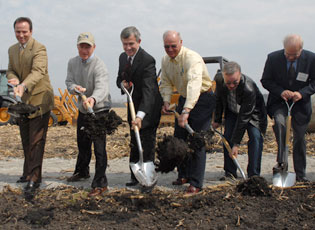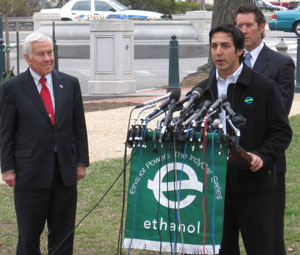 Agriculture Secretary Mike Johanns spent Wednesday in the state of Indiana talking about domestic fuel.
Agriculture Secretary Mike Johanns spent Wednesday in the state of Indiana talking about domestic fuel.
First, the secretary joined Governor Mitch Daniels to break ground for BioTown, USA’s Phase II technology suite. BioTown is the country’s first effort toward creating communities where all energy needs are met through biorenewable resources.
 At that event, Johanns also announced the availability of $176.5 million in loan guarantees and $11.4 million in grants to support investments in renewable energy and energy efficiency improvements by agricultural producers and small businesses.
At that event, Johanns also announced the availability of $176.5 million in loan guarantees and $11.4 million in grants to support investments in renewable energy and energy efficiency improvements by agricultural producers and small businesses.
“By promoting energy efficiency and development of energy sources that are farm based and renewable, we’re taking another step toward achieving the President’s goal of reducing America’s gasoline consumption by 20 percent in ten years,” said Johanns. “We hope to dramatically expand renewable energy programs like these, as reflected in our 2007 farm bill proposals.”
Finally, Johanns concluded the day with a renewable energy roundtable discussion at Purdue University in Indiana where he talked about the administration’s 2007 Farm Bill proposals and fielded energy-related questions with a number of other panelists. He also introduced a new web-based tool designed to make energy-related activities from across the Department accessible from a single web page. The Energy Matrix is a comprehensive collection of information on all of USDA’s energy-related programs, research efforts, funding opportunities, and technical assistance.


 South Dakota-based
South Dakota-based  Ethanol was the center of attention outside the US Senate building in Washington DC Wednesday as Senators Richard Lugar and Evan Bayh of Indiana joined with members of the ethanol industry to mark the use of 100 percent fuel grade ethanol in the IndyCar Series starting in Homestead this weekend.
Ethanol was the center of attention outside the US Senate building in Washington DC Wednesday as Senators Richard Lugar and Evan Bayh of Indiana joined with members of the ethanol industry to mark the use of 100 percent fuel grade ethanol in the IndyCar Series starting in Homestead this weekend.  EPIC Executive Director Tom Slunecka said several other lawmakers in addition to Sens. Lugar and Bayh attended the event as well, including Sen. Norm Coleman of Minnesota.
EPIC Executive Director Tom Slunecka said several other lawmakers in addition to Sens. Lugar and Bayh attended the event as well, including Sen. Norm Coleman of Minnesota. EPIC board member Greg Krissek, Director of Government affairs for ethanol design firm
EPIC board member Greg Krissek, Director of Government affairs for ethanol design firm 



 The president talked about his goal of reducing America’s gasoline consumption by 20 percent over the next 10 years and how hybrid cars and flex-fuel vehicles can help achieve that goal.
The president talked about his goal of reducing America’s gasoline consumption by 20 percent over the next 10 years and how hybrid cars and flex-fuel vehicles can help achieve that goal. Denver-based
Denver-based  The City of Rome, Italy could convert all of its 2800 buses to biodiesel by the end of 2008.
The City of Rome, Italy could convert all of its 2800 buses to biodiesel by the end of 2008.  The CEO of Wisconsin’s
The CEO of Wisconsin’s